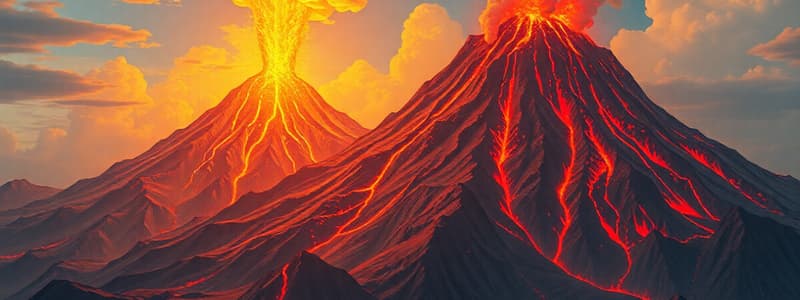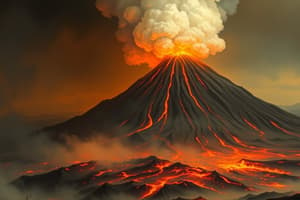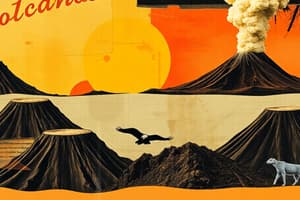Podcast
Questions and Answers
What is a volcano?
What is a volcano?
A volcano is an opening in the Earth's crust that allows molten rock, gases, and debris to escape to the surface.
What are the four states or territories that have the most active volcanoes in the United States?
What are the four states or territories that have the most active volcanoes in the United States?
Alaska, Hawaii, California, and Oregon.
Volcanic ash can travel hundreds of miles and cause severe health problems.
Volcanic ash can travel hundreds of miles and cause severe health problems.
True (A)
What type of volcano has steep sides and a symmetrical cone shape?
What type of volcano has steep sides and a symmetrical cone shape?
What causes the explosive eruption of a stratovolcano?
What causes the explosive eruption of a stratovolcano?
Which of the following volcanoes are shield volcanoes?
Which of the following volcanoes are shield volcanoes?
What is the name given to low viscosity, runny lava?
What is the name given to low viscosity, runny lava?
What are the world's largest active volcanoes?
What are the world's largest active volcanoes?
What is another name for cinder cone volcanoes?
What is another name for cinder cone volcanoes?
What are airborne fragments of lava called?
What are airborne fragments of lava called?
What is the approximate height of cinder cone volcanoes?
What is the approximate height of cinder cone volcanoes?
What are the two predominant types of volcanic eruptions?
What are the two predominant types of volcanic eruptions?
In an effusive eruption, magma rises through the surface and flows out of the volcano as a viscous liquid called lava.
In an effusive eruption, magma rises through the surface and flows out of the volcano as a viscous liquid called lava.
What are pieces of magma that are torn apart as a volcano erupts called?
What are pieces of magma that are torn apart as a volcano erupts called?
What is metamorphism?
What is metamorphism?
What are the most important agents of metamorphism?
What are the most important agents of metamorphism?
What is mechanical dislocation in metamorphism?
What is mechanical dislocation in metamorphism?
What is chemical recrystallization in metamorphism?
What is chemical recrystallization in metamorphism?
What type of metamorphism results primarily from mechanical deformation?
What type of metamorphism results primarily from mechanical deformation?
What type of metamorphism occurs primarily as a consequence of increases in temperature?
What type of metamorphism occurs primarily as a consequence of increases in temperature?
What type of metamorphism results from the general increase, usually correlated, of temperature and pressure over a large area?
What type of metamorphism results from the general increase, usually correlated, of temperature and pressure over a large area?
What is an extreme condition of regional metamorphism where partial melting occurs called?
What is an extreme condition of regional metamorphism where partial melting occurs called?
What is retrograde metamorphism?
What is retrograde metamorphism?
What type of metamorphism occurs in the presence of water at high temperature and pressure?
What type of metamorphism occurs in the presence of water at high temperature and pressure?
Flashcards
Volcano
Volcano
An opening in Earth's crust that allows molten rock, gases, and debris to escape to the surface.
Volcanic Eruption
Volcanic Eruption
An event where lava and debris flow from a volcano, potentially destroying surroundings.
Volcanic Ash
Volcanic Ash
Fine particles of rock and glass that can travel far from the eruption and affect health.
Stratovolcano
Stratovolcano
Signup and view all the flashcards
Shield Volcano
Shield Volcano
Signup and view all the flashcards
Cinder Cone Volcano
Cinder Cone Volcano
Signup and view all the flashcards
Effusive Eruption
Effusive Eruption
Signup and view all the flashcards
Explosive Eruption
Explosive Eruption
Signup and view all the flashcards
Metamorphism
Metamorphism
Signup and view all the flashcards
Mechanical Dislocation
Mechanical Dislocation
Signup and view all the flashcards
Chemical Recrystallization
Chemical Recrystallization
Signup and view all the flashcards
Dynamic Metamorphism
Dynamic Metamorphism
Signup and view all the flashcards
Contact Metamorphism
Contact Metamorphism
Signup and view all the flashcards
Regional Metamorphism
Regional Metamorphism
Signup and view all the flashcards
Retrograde Metamorphism
Retrograde Metamorphism
Signup and view all the flashcards
Metasomatism
Metasomatism
Signup and view all the flashcards
Hydrothermal Metamorphism
Hydrothermal Metamorphism
Signup and view all the flashcards
Tectonic plates
Tectonic plates
Signup and view all the flashcards
Study Notes
Volcanoes
- Definition: A volcano is an opening in the Earth's crust allowing molten rock, gases, and debris to escape to the surface.
- Active Volcanoes: Alaska, Hawaii, California, and Oregon have the most active volcanoes, but others exist across states and territories.
- Eruption Hazards: Volcanic eruptions can involve flows of lava at speeds up to 100 mph, destroying everything in its path. Volcanic ash, travelling hundreds of miles, can cause severe health problems.
Types of Volcanoes
A. Stratovolcanoes
- Shape: These are majestic giants with steep symmetrical cone shapes.
- Lava Characteristics: Their lava is very thick (viscous or sticky), preventing easy flow.
- Formation: Lava builds up around the vent, creating the characteristic steep-sided, triangular shape.
- Eruptions: Because the magma is viscous, gases are trapped, creating pressure that builds inside the volcano. This, often leads to explosive eruptions.
B. Shield Volcanoes
- Shape: Have gentle slopes formed from runny lava that spreads far from the source
- Examples: Mauna Kea and Mauna Loa are examples
- Location: These are the world's largest active volcanoes, rising nearly 9 km above the seafloor around the Hawaiian Islands.
C. Cinder Cone Volcanoes
- Description: These are typically the most common cone-shaped volcano.
- Formation: Ejected lava fragments (tephra), rapidly cool and fall as cinders, piling up around the vent to form a crater at the summit.
- Size: Typically between 300 and 1,200 feet in height.
- Formation Time: Form over relatively short periods, potentially a few months to a few years.
- Occurrence: Can occur as single volcanoes or parasitic cones on the sides of larger stratovolcanoes or shield volcanoes.
Types of Volcanic Eruptions
A. Effusive Eruptions
- Description: Magma rises through the surface and flows out of the volcano as a viscous liquid called lava.
B. Explosive Eruptions
- Description: Magma is torn apart as it rises and reaches the surface as fragments called pyroclasts
Metamorphism
- Definition: Mineralogical and structural changes in solid rocks due to physical or chemical conditions differing from the original forming conditions.
- Key Agents: Temperature, pressure, and fluids are the primary agents affecting metamorphism.
Types of Metamorphism Processes
A. Mechanical Dislocation
- Description: Rock deformation is a consequence of differential stress
B. Chemical Recrystallization
- Description: A mineral assemblage changes equilibrium due to temperature and pressure changes, but the basic structure remains unchanged.
Types of Metamorphism
A. Dynamic (or Cataclasis)
- Description: Occurs primarily from mechanical deformation, with limited long-term temperature change.
- Textural Impacts: Produces diverse textures ranging from breccias (angular rock fragments) to fine-grained, granulated or powdered rocks displaying foliation and lineation.
- Grain Impact: Large pre-existing mineral grains can be deformed.
B. Contact Metamorphism
- Description: This metamorphism occurs in response to increased temperature where differential stress is minimal.
- Occurrence: Typical near igneous intrusions, causing concentric zones with changing mineral assemblages.
- Pressure: Pressure is near-constant, and resulting rocks have equidimensional grains, typically fine-grained from the brief metamorphism time
C. Regional Metamorphism
- Description: Results from widespread increase in temperature and pressure.
- Grade Representation: Classified by mineral assemblages either giving the relative or absolute temperature values calibrated via laboratory experiments.
- Variations: Can be subdivided into pressure-temperature conditions based on observed mineral assemblages.
Other Metamorphism Types
D. Retrograde Metamorphism
- Description: Response of mineral assemblages to decreasing temperature and pressure.
E. Metasomatism
- Description: Metamorphism involving addition or subtraction of components from the original assemblage. Potentially involving multiple metamorphic events.
F. Hydrothermal Metamorphism
- Description: Changes occur in the presence of water at high temperature and pressure, influencing resultant mineralogy and reaction rates.
Studying That Suits You
Use AI to generate personalized quizzes and flashcards to suit your learning preferences.




